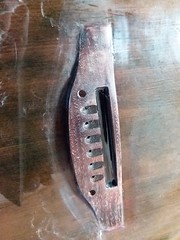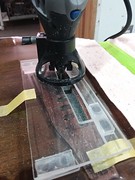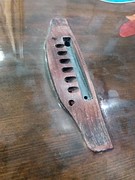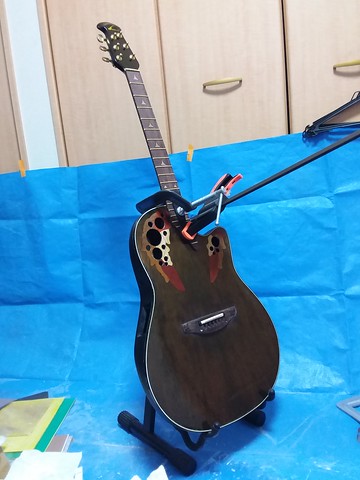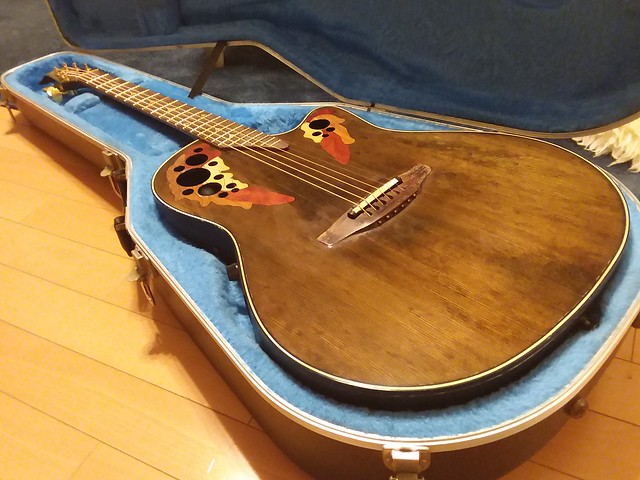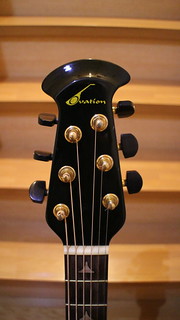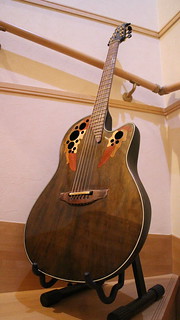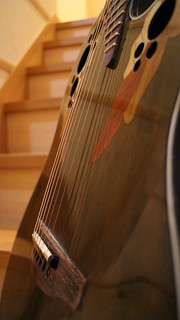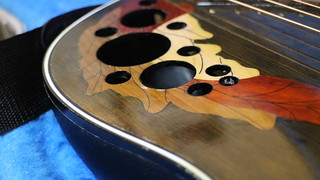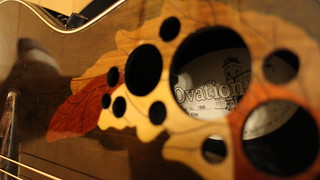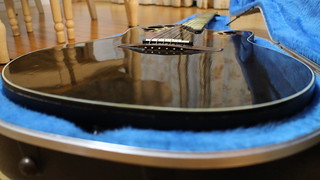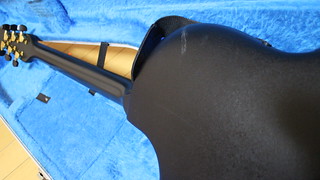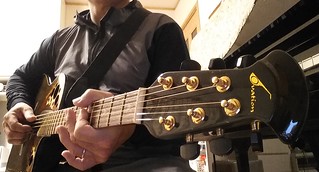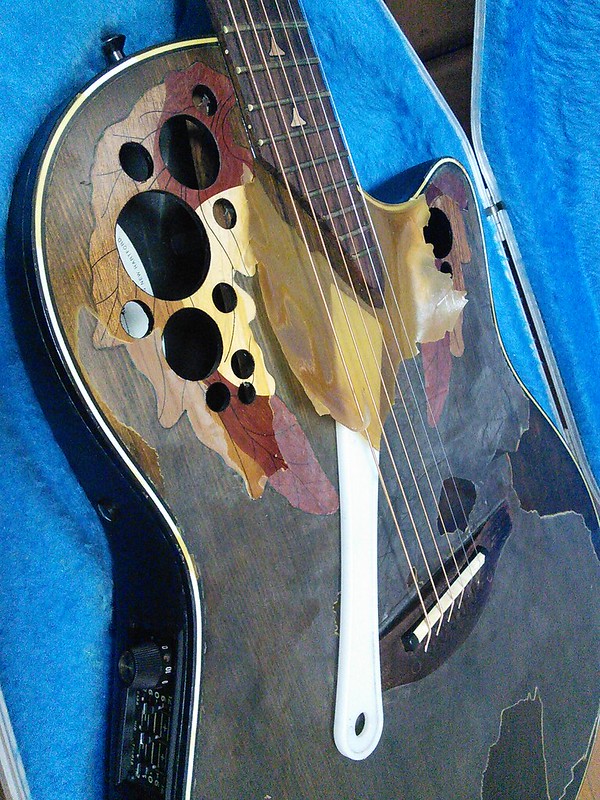|
| ||
| The Ovation Fan Club | ||
| ||
| Random quote: "I've always felt that blues, rock 'n' roll and country are just about a beat apart."-Waylon Jennings |
 1990 Elite 1868 Project 1990 Elite 1868 Project
| View previous thread :: View next thread | |
| Member Communities -> Bottom Feeding Luthiery Guild | Message format | |
| arumako |
| ||
Joined: October 2012 Posts: 1091 Location: Yokohama, Japan | 2wheeldrummer - 2019-01-11 8:17 AM ...perseverance and patience will pay off in the end!!!! Thanks 2wheeldrummer! Not looking for a big pay-off. Hoping for an instrument that "sound" that we all love so much. Already seeing limitations with the epoxy finish I used. Because of my miscalculation and resin over flow, there was a lot of flashing that needed to be cleaned up around the bowl and epis. Maybe my mixing was bad or the resin just got old. The stuff is very brittle, and chips off too easily. The chips are hardly noticeable, but I was hoping for a more durable result. Good lesson learned! Anyway, the bridge's saddle slot needed to be routed, and the handy jig used for my 5986 Nakao came in handy again...
Everything fit together pretty well; so after some dry runs of clamping the neck into place, I decided to put it all together. Despite my misgivings about the Finishing Resin, I have nothing but praise for Z-Poxy adhesives. Scuffed up the body with 100 grit sp to ensure good adhesion. Put everything in the right place to ensure process efficiency. Turned to Z-Poxy's 30 Minute Epoxy product again. Applied just the right amount of adhesives under the fret board extension. Placed the neck in the correct position and finger-tightened the neck bolt (I know I've said this many times before; but man, I love these K-bar necks). Grabbed my first clamp... squeeze, squeeze, squeeze... okay, that's about right... turned around to grab my second clamp, and CRACK! No, no, not the guitar, (thank God! That was my first thought too) but my first clamp... looks fine, but something in the clamping mechanism must have cracked... wasn't expecting this! Would have been SOL , had this been a mid-depth bowl! Time to invest in some better clamps... After the minor mishap, I was able to run to my shed and grab a standard C-Clamp... not exactly "textbook", but nothing about this project has been "textbook" after all. LOL!
Neck fit and position - perfect! Fret maintenance in 24-hours, install pre-amp and take her for a spin! Woohoo... Got a GOOD feeling about this one! | ||
| |||
| DanSavage |
| ||
Joined: June 2012 Posts: 2339 Location: Pueblo West, CO | arumako - 2019-01-14 12:50 AM Already seeing limitations with the epoxy finish I used. Because of my miscalculation and resin over flow, there was a lot of flashing that needed to be cleaned up around the bowl and epis. Maybe my mixing was bad or the resin just got old. The stuff is very brittle, and chips off too easily. The chips are hardly noticeable, but I was hoping for a more durable result. Good lesson learned! Hi Ken, I've been following your progress on this. I'm glad to see it nearing completion. Generally speaking, the slower an epoxy cures the more rigid (brittle) it will be once cured. The ZPoxy finishing resin is pretty much the most rigid formulation ZPoxy sells. It's main use in modeling is as a laminating resin to apply lightweight fiberglass to the outer skin of the model as a base for the painted finish. I'm curious to read how it sounds. Dan | ||
| |||
| arumako |
| ||
Joined: October 2012 Posts: 1091 Location: Yokohama, Japan | DanSavage - 2019-01-14 6:45 AM Hi Ken, I've been following your progress on this. I'm glad to see it nearing completion. Generally speaking, the slower an epoxy cures the more rigid (brittle) it will be once cured. The ZPoxy finishing resin is pretty much the most rigid formulation ZPoxy sells. It's main use in modeling is as a laminating resin to apply lightweight fiberglass to the outer skin of the model as a base for the painted finish. I'm curious to read how it sounds. Dan Hi Dan! I've surely missed your wisdom and insight! Thanks for chimming in! Yeah, I'd have to say my Finishing Resin experiment ended as a failure. The chipping also seems to indicate that the epoxy finish isn't adhering well to the nitro based sanding sealer. I'm guessing using the Finishing Resin instead of the sanding sealer, and following that up with a finishing epoxy would have been better. I was getting a lot of bubbling with the FResin; so as an experiment, I tried some 30-minute Z-Poxy on some wood blanks, and that was much easier to work with (no bubbling) and my sample finished durable without chipping. Unfortunately, I opted to use the FResin because, I kept assuming the 30-minute product as an "adhesive". Still, a good lesson learned. This current finish will probably chip off after a year or two. Will probably remove the epoxy and shoot a nitro clear coat when the time comes. While you're at it... got any other advice for me? Oh yeah, my son is building his 1st electric kit from Stewmac @ college (X-mas gift). He's planning on using the Eastwood 2K over a sonic blue lacquer. Will that work out okay? | ||
| |||
| arumako |
| ||
Joined: October 2012 Posts: 1091 Location: Yokohama, Japan | After at least four years of silence my 1990 Elite sings again! Woohoo! The recycled AA Sitka spruce top is only just starting to get back into the swing of things...
She is looking & sounding mighty fine indeed! Here's another shot of her resting in her case!
Will post sound byte later, but I can't thank the BFLG enough for all your generous encouragement. Think I'm gonna take DetlefMichel's advice and swap my stock gold tuning buttons for some black ebony ones. Woohoo!
Edited by arumako 2019-01-16 11:09 AM | ||
| |||
| marenostrum |
| ||
Joined: August 2007 Posts: 1008 Location: Tuscany, Italy | Well done job, Ken. Congratulations ! | ||
| |||
| Jonmark Stone |
| ||
Joined: May 2008 Posts: 1561 Location: Indiana | |||
| |||
| Love O Fair |
| ||
Joined: February 2016 Posts: 1872 Location: When?? | Just think how nice it would have turned out if you hadn't rushed through the project. --or-- That promise you wouldn't shave your beard until you finished this has at least kept the floor swept nicely. --or-- Don't worry, there will eventually be a red light and the train will stop. --or-- --or-- --or.. Nice job, Ken! Congratulations, and thanks for an interesting journey. Your skill and talent once again shine through! Oh, and your patience, too. (sorry, couldn't resist) Edited by Love O Fair 2019-01-16 1:45 PM | ||
| |||
| moody, p.i. |
| ||
Joined: March 2002 Posts: 15678 Location: SoCal | Looks beautiful! Looking forward to hearing it..... | ||
| |||
| DanSavage |
| ||
Joined: June 2012 Posts: 2339 Location: Pueblo West, CO | arumako - 2019-01-15 7:12 PM Hi Dan! I've surely missed your wisdom and insight! Thanks for chimming in! Yeah, I'd have to say my Finishing Resin experiment ended as a failure. The chipping also seems to indicate that the epoxy finish isn't adhering well to the nitro based sanding sealer. I'm guessing using the Finishing Resin instead of the sanding sealer, and following that up with a finishing epoxy would have been better. I was getting a lot of bubbling with the FResin; so as an experiment, I tried some 30-minute Z-Poxy on some wood blanks, and that was much easier to work with (no bubbling) and my sample finished durable without chipping. Unfortunately, I opted to use the FResin because, I kept assuming the 30-minute product as an "adhesive". Still, a good lesson learned. This current finish will probably chip off after a year or two. Will probably remove the epoxy and shoot a nitro clear coat when the time comes. While you're at it... got any other advice for me? Oh yeah, my son is building his 1st electric kit from Stewmac @ college (X-mas gift). He's planning on using the Eastwood 2K over a sonic blue lacquer. Will that work out okay? One good thing about using the finishing resin is that the hardness won't deaden the sound. Keep in mind that the finishing resin and 30-minute are both epoxies. AFAIK, the main difference is the cure time and viscosity. There are very few materials that epoxy will form a chemical bond. It usually only makes a mechanical bond. If you use sandpaper with too fine of a grit the epoxy won't get enough tooth and it can separate. I'll usually use 320-grit as the final prep. I agree. If it starts looking too bad you can always peel it off and put something else down. Eastwood 2K over lacquer should be fine, but finishing a test piece first would be in order. At the very least the lacquer will need to be sanded to give the finish some tooth. Edited by DanSavage 2019-01-16 6:56 PM | ||
| |||
| Love O Fair |
| ||
Joined: February 2016 Posts: 1872 Location: When?? | @Dan - >>>'ll usually use 320-grit as the final prep.<<< A step that I am curious about. Is that wet or dry? If wet, do you first dampen the paper, or the surface, or both? How deep? | ||
| |||
| DanSavage |
| ||
Joined: June 2012 Posts: 2339 Location: Pueblo West, CO | Love O Fair - 2019-01-16 6:59 PM @Dan - >>>'ll usually use 320-grit as the final prep.<<< A step that I am curious about. Is that wet or dry? If wet, do you first dampen the paper, or the surface, or both? How deep? Whether I dry sand or wet sand depends upon how far along in the finishing process I'm at. Initial sanding is done dry so I don't get the wood wet. Once I've got a decent base, I'll switch over to wet sanding. Once I get to the wet-sanding step I move up to 400-grit. I sand the top using a 2"x2"x3" styrofoam block with whatever grit sandpaper I'm using. I keep a small plastic bowl with some water in it. I dip the sanding block in the water, shake off the excess, then sand a 6"x6" area at a time. When I'm done sanding that area, I wipe off the sanding slurry with a paper towel and move on to the next area. I try to sand off as little as possible. It's really easy to take off too much and burn through the finish into the bare wood. So, I only sand the area a little bit, clean off the slurry and dry the area to check my progress, then repeat until all the surface imperfections, such as orange peel, etc., are gone. Edited by DanSavage 2019-01-17 1:41 AM | ||
| |||
| DetlefMichel |
| ||
Joined: May 2011 Posts: 760 Location: Muenster/Germany | ...if I go back to page 1 and watch the pics...you made a wonderful guitar out of this piece of junk. The top with the inlaid epis makes it look look like a 3k$ guitar. I just love it. Chapeau! | ||
| |||
| Love O Fair |
| ||
Joined: February 2016 Posts: 1872 Location: When?? | Thanks for the reply and sanding tips, Dan. I missed it from last week, but I AM paying attention. We have an old oak table here with a top finish that looks beaten to something like the surface of your workbench, and since I so badly suck at finish woodwork I think I'd better start my career as such with the table top and hope that one day I am able to graduate tongue-in-cheek to a decent musical instrument. In the meantime I'll buy a tablecloth just in case. You guys amaze me. | ||
| |||
| arumako |
| ||
Joined: October 2012 Posts: 1091 Location: Yokohama, Japan | DanSavage - 2019-01-16 8:53 AM There are very few materials that epoxy will form a chemical bond. It usually only makes a mechanical bond. If you use sandpaper with too fine of a grit the epoxy won't get enough tooth and it can separate. I'll usually use 320-grit as the final prep. Thanks for the valuable tip Dan. Yup, went all the way up to 1000 grit with the sealer. That pretty much left the epoxy with nothing to grab on too. But I've learned so much from the BFLG on this project. Can't wait to tackle my next project. And thanks to everyone for the nice comments. Really appreciate your interest and encouragement! Been real hectic over the last few weeks; after stringing her up with my fav Adamas 1919E strings, I've been taking her through the paces. She took a few days to 'open-up', and I was tempted to Prime Vibe the stiff sound board, but resisted the temptation. I took DetlefMichel's advice and ordered the ebony tuning buttons. They arrived the other day and were immediately installed. WOW! I really like the understated look! The inlayed epis really look nice too.
Unfortunately, the brittle epoxy finish has already started chipping around the epis and edges of the guitar. However, the 'Ol New Hartford label reminds me of her noble lineage which promises articulate resonance chips or not!
And despite the polishing and buffing, I couldn't get the finish completely level. Of course, the over-spill from my epoxy miscalculation will need to be covered with black paint.
Was able to make a foam pad for the manhole cover... not exactly uniform or symmetrical, but good enough to secure the cover in place. All-in-all she's a joy to play.
So, wanted to leave some conclusions about my various experiments implemented in this project as I close this running 4-year thread down... 1. Re-purposed original AA Sitka Spruce top with ebonized stain: excellent results. 2. Inlayed Epaulets: excellent results. 3. Warwick Bell-bronze frets: Bear to install, but looks very good. 4. Re-radiused 20" fret board: improves finger's attack angle, but brings the strings just a hair closer, making it difficult for my stubby fingers to get clean access to the strings. Need a new nut to resolve this issue. 5. Nitro-cellulose sealer & Epoxy Resin finish: Failure. Sanded sealer with sand paper that was too fine (1000 grit). Epoxy could not securely adhere to sealer. The chosen finishing epoxy was too brittle and began chipping away. However, despite the failed experiment, this SSB sounds incredible! She is the loudest SSB I've ever heard. No doubt the original sound board chosen and built at the Mother Ship combined with the cosmetically failed, but resonantly successful nitro/epoxy finish, and the bell-like toned Warwick frets all contribute to that dynamic and punchy uniquely Ovation voice. Bass tones are not deep, but very strong; as a matter of fact, she blows away my Mid Depth bowl CC247 that just came out of a 190 hour Prime Vibe session (Prime Vibe really opened up the spruce-lamInate top of my Celebrity - definitely recommend the treatment for all laminates!). Here's a short demo... My pudgy fingers are still trying to get used to the closer strings of the 20" radiused fret board so forgive my uninspiring technique! <iframe src="https://www.youtube.com/embed/HMQtKKXyWVk" frameborder="0" width="560" height="315"> a link just in case... https://youtu.be/HMQtKKXyWVk As is always the case, the camera's mic doesn't do this beautiful sounding instrument justice, but with a new nut and maybe a full epoxy or nitro-cellulose finish down the road somewhare, I might be able to say, "She sounds as good as she looks." But for now, I'll just settle for, "She sounds way better than she looks!" Thanks for letting me share BFLG! Edited by arumako 2019-02-05 8:18 AM | ||
| |||
| DanSavage |
| ||
Joined: June 2012 Posts: 2339 Location: Pueblo West, CO | Hi Ken, Thanks for the closing comments of this project. It turned into a really nice guitar. WRT to point #5, the finish, I'm finding that the fewer different types of finish applied to the top, the better. For example, a lot of luthiers recommend that you lay on a coat of shellac before routing the binding/purfling channel to help prevent tear-outs. But, what I found is that once I started scraping down the binding/purfling I would inevitably scrape off some of the shellac exposing the bare wood underneath. Because the shellac is not translucent, this would leave parts of the top that was lighter than other areas. So, I stopped doing the shellac layer. As you know I was a fan of Minwax poly-u finish, either as an 'primer' to the Eastwood 2K, or as the sole finish. What I found was that the poly-u actually behaved a lot like lacquer in that it really should be allowed to dry for a full month so that all the solvents had time to evaporate and 'shrink' the finish prior to cutting and polishing. Not doing so led to the finish shrinking which left the guitar top with what looked like a 'vintage' finish instead of the glassy-smooth finish usually seen on Ovations, even when top-coated with EW2K. On the plus side, a thinner finish is always better than a thicker one. I've arrived at the point where I have decided to stick with EW2K as the sole finish, mainly because it's a catalytic finish instead of an evaporative one. This means, low shrinkage during the post-polishing period. Of course, I've only done one guitar finished only with EW2K and that one got shipped off a couple of months ago so I haven't had a chance to view it long-term, and probably won't have the chance unless the buyer posts photos a year or so from now. I'm not sure if you've done a nitro finish on a guitar, but I have and I probably won't do it again. It was a major pain. Because the coats go on so thin, it takes a lot to build up the finish to a decent thickness for finishing. Then, once it's done it's still a pretty delicate finish. Edited by DanSavage 2019-02-06 11:59 AM | ||
| |||
| arumako |
| ||
Joined: October 2012 Posts: 1091 Location: Yokohama, Japan | DanSavage - 2019-02-06 1:58 AM WRT to point #5, the finish, I'm finding that the fewer different types of finish applied to the top, the better. I've arrived at the point where I have decided to stick with EW2K as the sole finish, mainly because it's a catalytic finish instead of an evaporative one. This means, low shrinkage during the post-polishing period. Hey Dan! Thanks for your insights. Fewer different finishes makes a lot of sense, and I think I'll stick to one type of finish from now on. I've read and heard about the shellac top coat to protect the wood when scrapping the binding down; and in addition to sealing the AA spruce top, the relatively thick coat of nitro sanding sealer did just that. Interestingly enough the JP brand sanding sealer I used is catalyzed, and dries and finishes really quickly and nicely. For some reason, polyurethane spray-can finishes are unheard of over here. Other poly finishes are generally very very expensive (and almost always water-based). As the temperature changes here in Japan (incidentally it's snowing out today!) begin to affect the various finishes on my 1868, I'm pretty sure there's going to be some shrinkage differences that will make chipping and peeling more and more pervasive. However, like the sanding sealer I used, there's a plethora of catalyzed nitro products over here and I'm kinda keen to try some of those. DanSavage - 2019-02-06 1:58 AM I'm not sure if you've done a nitro finish on a guitar, but I have and I probably won't do it again. It was a major pain. Because the coats go on so thin, it takes a lot to build up the finish to a decent thickness for finishing. Then, once it's done it's still a pretty delicate finish. I used nitro on my electric guitars in the past with great results, never on acoustics though. "Major pain" is a good description! However, nowadays if I'm going to go through the pain of using nitro, I would much rather do a French Polish (shellac). With nitro, you gotta spray and wait and wait and wait, and do it all over again, but with FP, instead of waiting you get to rub and rub and rub; and for some reason, I find the pore filling to the final finish process a lot of fun! Of course, you don't get real polyurethane type of protection, but classical guitars are not meant to be banged around like our Os! Having said that, I'm really impressed with the acoustic characteristics of my 1868. It is like no other O that I own. Of course, it's no "torrefied wonder", but the response of the re-purposed AA top is clear, resonant and sustaining. As mentioned previously in the thread, it out performs my mid-depth CC247, even after the 190 hour PV session (which really improved the voice tremendously). My only other "onhand" SSB is my sons 1861-5 - no contest. I loved the 5986 Nakao too - it's close, but it can't keep up with this Elite. Of course, I must admit that maximizing the resonance of the top of an SSB is somewhat of an exercise in stupidity (since these were designed to be plugged-in), but I keep wondering what my 1117-4 and my CS249 (nylon) would sound like with a FP or catalyzed nitro finishes. Won't get to my iDea project for awhile, but my head is mulling things over...that could be dangerous! By the way, I never could embed YT videos very effectively. Apologize for the link only in my previous post. Ran out of time, as I tried to edit the video into the post - oh well. So, here's some info that I was hoping to include in my last post; string action: 6th string 12th fret - 2mm; 1st string 12th fret 1.7mm with no buzzing. Also, while Warwick's Bell Bronze frets work well and provide sparkling highs, the gains are not worth the extra effort they take to install them (slightly wider fret slots needed). Just go with EVO Golds. Okay, I think that's it! Stay warm and Happy strumming! Edited by arumako 2019-02-09 2:27 AM | ||
| |||
| DetlefMichel |
| ||
Joined: May 2011 Posts: 760 Location: Muenster/Germany | " maximizing the resonance of the top of an SSB is somewhat of an exercise in stupidity"....NO! It´s always an heroic deed!! | ||
| |||
| arumako |
| ||
Joined: October 2012 Posts: 1091 Location: Yokohama, Japan | Redemption Time!
As Dan said, sanding the sanding sealer down to 1000 grit really gave the epoxy finish nothing to grab onto! It just peeled off like the shell of a boiled egg! The discoloration of the epoxy (although it is a bit colored to begin with) suggests either a mixing or shelf-life problem. In either case, it's redemption time! Still need to think things through; but leaning toward a lacquer finish this time. Will sand this baby down to 300 grit, shoot a few thin sanding sealer coats and finish her up with some nice clear lacquer, polishing and buffing! To my great surprise, this 1868 holds its own alongside the 1678AV50, and even the 1680 (even with the finish peeled off!) - completely different, but spectacular nonetheless! Gosh, this is fun! | ||
| |||
| Love O Fair |
| ||
Joined: February 2016 Posts: 1872 Location: When?? | Dang! And she was so pretty.. but glad to know it was from usage in the elements instead of peeling in the closet. I'm amazed at how "boiled egg" clean it comes off. | ||
| |||
| Jonmark Stone |
| ||
Joined: May 2008 Posts: 1561 Location: Indiana | arumako - 2021-09-27 3:22 AM Still need to think things through; but leaning toward a lacquer finish this time.
Dan used an Eastwood product on my parlor. It's top-notch. | ||
| |||
| arumako |
| ||
Joined: October 2012 Posts: 1091 Location: Yokohama, Japan | Well, my 1115 Project is on hold as I seem to have misplaced my CFRP strips. Ordered some new strips that should arrive in a couple of days so it's time for me to revisit this 1868 to re-do the finish. As Jonmark Stone identified, I would love to use Dan's goto finish - the Eastwood 2K; but the stuff is not available in my neck of the woods. There are some good water-based poly finishes, but I've recently restored a 1958 Yamaha with a new generation nitro-cellulose lacquer (owner wanted the restoration to be as close to original as possible) that has added catalysts for clearer and harder drying. It'll hang out to dry for a few more weeks, but the stuff is pretty impressive (so far).
Once the gaps and dings are dried, the sides, bridge and neck joint will be taped up and a new layer of sanding sealer will be applied to the entire top. One of the difficulties with these epi'd Os is removing the old finish inside of the epis. I didn't do a very good job of cleaning these areas out last time (before applying the previous experimental epoxy finish). Wanted to really get these areas clear of old finish this time. Used some 220 grit sand paper taped around a long bamboo skewer like so...
Wrapped the sand paper around the bamboo skewer (counter clockwise) and loaded the skewer into my drill, and voila!
The bamboo shaft is flexible and sands with consistent centrifugal force all around. This method is far more forgiving (for me anyway) than using a metal rod with a slit cut in the tip for the sandpaper. I can use a thicker cut of sand paper and move my drill bit up and down further without worrying about the sand paper going too deep or shallow potentially damaging the top. This 1868 is one of the best sounding shallow bowl guitars I've ever played, and I'm thinking the nitro-cellulose lacquer finish is going to respond a bit more freely than a poly finish. Very happy to get this project off the shelf and moving forward again! Thanks for letting me share my progress OFC/BFLG! Will be back in a day or two! | ||
| |||
| Love O Fair |
| ||
Joined: February 2016 Posts: 1872 Location: When?? | @arumako - >>>the Eastwood 2K; but the stuff is not available in my neck of the woods<<< Eastwood 2K is the bomb.. great stuff.. and I do understand how local availability can be limited due to international chemical trade on the retail market. But something I am not in understanding of is.. can a private party ship it to you direct? Maybe from your kids here in California, or me, or someone else. | ||
| |||
| arumako |
| ||
Joined: October 2012 Posts: 1091 Location: Yokohama, Japan | Love O Fair - 2025-04-13 4:59 AM But something I am not in understanding of is.. can a private party ship it to you direct? Maybe from your kids here in California, or me, or someone else. Thanks Al! I appreciate your kindness! There are major restrictions when it comes to shipping flammable sprays to Japan. Even if the USPS/Fed-Ex/DHL accepts the shipment, once it arrives in Japan, customs will have a field day requiring me to submit all kinds of documents to prove that I am an authorized importer of flammable material. If my son or daughter or someone else (including Al) attempts to hand carry more than 100ml of the stuff onto an airplane, it will get confiscated upon arrival. With all the high-tech devices used to check luggage nowadays, there is no way to smuggle aerosol sprays into Japan without security and customs finding the stash. The smuggler won't have to spend any prison time, but confiscation will be inevitable. Thanks for the kind offer though! Would rather spare my family and friends the humiliation and just settle for nitro-cellulose! Lol! Now, that the sanding sealer has dried, some 240 grit sandpaper (don't want to repeat my 1000 grit fiasco!) was used to wet sand the surface to prepare for the final coats of lacquer.
This is the 3rd shot of lacquer. I learned from Dan and the BFLG that unlike polyurethane, lacquer doesn't finish in coats. Each shot melds into the previous layer. Only down side is the brain-cell killing chemicals (if inhaled) and the long drying time. Gloves and masks are a must when spraying this stuff! Pretty happy with the progress so far! Should have done this the first time around! Tomorrow the very slight "orange peel" will be wet sanded with 320 grit sand paper followed by 3 more (coats) shots! Yes! Edited by arumako 2025-04-17 6:26 AM | ||
| |||
| arumako |
| ||
Joined: October 2012 Posts: 1091 Location: Yokohama, Japan | Wet sanded the dried nitro-cellulose lacquer. Started the next layer of clear coat, and a bit of bubbling began to appear near the cutaway area. Heating epoxy resin eliminates bubbles in the finish, but apparently nitro doesn't work that way, and the small hair dried area began to bubble up! Thinking also that some moisture remained after the wet sanding...
Gross, right? Fortunately, this is not as big a problem as it looks. Since nitro melds into the previous layer, sanding the bubbles out and re-shooting the area with fresh finish is all it takes. This time, I dry sanded the bubbled area.
Don't need to eliminate the bubbles completely. Just need to ensure the bubbles are popped and opened enough to allow new nitro in. Once the new nitro is in, the bubbles and the new finish meld together and even out. Over the years, I've found that using different style brushes really increase the odds of success. An equally important tool that's not pictured is an antcenter tweezer that I use to pick small insects and dust out of the finish.
Finally, with the bubbled area sanded and completely brushed clean; it was time to repair the damaged finish. Nothing different is done to spray the finish on. Just concentrated on the area in question and made sure there was no overspray, and
Just a one-day detour, and I am back on track! Cool, now it's time to turn my attention back to my 1115 parallel BFLG project! Be back in a bit! | ||
| |||
| tpa |
| ||
Joined: December 2004 Posts: 576 Location: Denmark | Nice, really nice. And as you mentioned before sometimes a bolt on neck is handy. Edited by tpa 2025-04-20 5:02 AM | ||
| |||
| Jump to page : 1 2 3 4 5 6 Now viewing page 5 [25 messages per page] |
| Search this forum Printer friendly version E-mail a link to this thread |
| This message board and website is not sponsored or affiliated with Ovation® Guitars in any way. | |
| (Delete all cookies set by this site) | |


